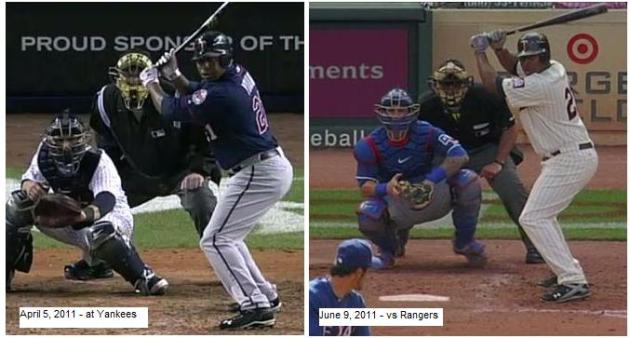Because
of one pitch, questions regarding Joe Mauer’s defensive abilities have surfaced.
Following
Friday’s Jose
Mijares versus Mauer incident, columnist Jim Souhan
blogged on the StarTribune.com stating that:
“I've always been told by Twins people that Mauer is not an exceptional pitch-caller.”
Then,
after Liriano’s rough outing on Saturday, Souhan relayed more rumblings
from the clubhouse on his blog:
“Liriano mentioned after the game that he didn't think the pitch he threw to Gomez was the right choice. Another shot at Mauer's pitch-calling?”
In
terms of Souhan’s “Twins people”, it’s hard to tell if that is in reference to
pitchers, coaches or front office members. Maybe it’s just people surrounding
him in the press box. Or possibly all of the above. It should be noted that in my
conversations with Rob Antony last spring, the team’s assistant GM offered
nothing but a glowing endorsement of Mauer’s handling of the pitchers.
Based on the current comments, it is hard to ignore what appears to be an growing sentiment that the pitching staff is
growing frustrated with Mauer’s pitch-calling. Of course, this is not new nor
is it the first instance of pitcher’s expressing displeasure in Mauer’s
selections. In 2008, Nick Blackburn, Glen Perkins and Slowey were all cited as
regular shake-off offenders. Reportedly, field management was not happy with
Kevin Slowey shaking
off the highly paid catcher as recently as last year. This year, Liriano
has been fingered as a pitcher lacking
confidence in his catcher choices.
For
Liriano, the results seem to speak for themselves when it comes to his pairing
with Mauer on the mound this year:
F. Liriano by Catcher 2011
|
|||||
PA
|
BB%
|
K%
|
OPS
|
Runs/G
|
|
Butera
|
115
|
16.5
|
11.3
|
.742
|
3.20
|
Rivera
|
128
|
7.8
|
28.9
|
.497
|
1.60
|
Mauer
|
66
|
15.5
|
16.6
|
.956
|
4.00
|
(via
Baseball-Reference.com)
Within this
small sampling you can see that Liriano has not worked well with
Mauer at all. Yes, those numbers are influenced by Liriano’s shaky start at the
season’s onset when the bulk of his time with Mauer was but it just makes me
wonder if Mauer’s approach when handling Liriano differs radically in
comparison with Rivera, who Liriano has been magnificent with.
In fact, it appears that Rivera is the favorite receiver among the Twins pitching staff. At least by the numbers:
Twins Pitching Staff by Catcher 2011
|
|||||
PA
|
BB%
|
K%
|
OPS
|
Runs/G
|
|
Butera
|
1348
|
8.3
|
13.5
|
.779
|
4.27
|
Rivera
|
739
|
7.5
|
18.5
|
.637
|
2.60
|
Mauer
|
548
|
8.2
|
16.4
|
.729
|
4.33
|
(via
Baseball-Reference.com)
Needless
to say, actually digging into what differentiates the catchers requires much
more extensive studies in pitch f/x for pitch selection. Unfortunately, it’s
not that simple so I will not be exploring that aspect of the trio’s
game-calling abilities today. Skimming the data from his starts against Texas
and San Diego compared to his most recent one in Milwaukee, there does not
appear to be any substantial difference in what was being called, just a
disparity in where his pitches were being thrown.
Nick
Blackburn credited Rivera has helping him rebound this season. According to ESPN.com’s
Buster Olney, Blackburn’s renaissance came in a chat with Rivera before
last month’s start against Chicago:
“The White Sox are aggressive and free-swinging at the plate, and Blackburn and Rivera decided before that May 4 start that they would work inside with fastballs. And this, in turn, would open up the outer half of the plate for Blackburn's offspeed pitches. The Minnesota right-hander allowed one run in 6.2 innings that day, results that reinforced something for Blackburn: If he pitched inside, aggressively, he would create more space for himself in another part of the strike zone. What this meant, too, was that Blackburn didn't have to be quite as precise with his command, because his margin for error with the strike zone would be larger.”
So,
wait. Did Mauer or Butera not have Blackburn throwing inside prior to that
start? Once again, that’s best answered through an extensive pitch f/x study.
Perhaps
it extends beyond simply pitch-calling.
Watching
Rivera work behind the plate, you can see why he might be able to coax more out
of his pitchers. He’s very visual and moves around the zone, giving directions
constantly. In his start against the Padres, Rivera
pounded the dirt to make sure Liriano knew to get his slider down against
the right-hander Ryan Ludwick. He did the same with
Blackburn with Alexi Ramirez at the plate. That’s how you avoid any
confusion on where you wanted that pitch and make sure you are on the same page
as a pitcher.
Mauer
isn’t nearly that mobile behind the plate. He doesn’t thrust his leg out to
ensure he gets as low in the zone as possible. He doesn’t do the fake-out hop
inside then jump to the outer-half of the zone that Rivera does at times. Does
Liriano, who has been all over the board as a pitcher this season, need that
kind of guidance that Rivera provides when he is behind the plate? Do the others, like Blackburn, respond better to this style of catching?
Because of
Justin Morneau’s injury, Mauer may be moved from out behind the plate to first
base on occasion, giving Rivera a chance to prove that his ability to handle
the pitching staff isn’t just a success due to a small sample size.





